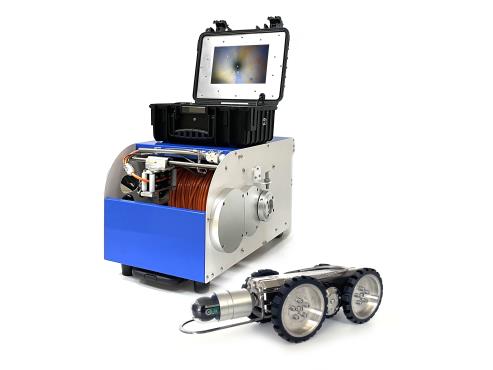Today’s cities rely heavily on efficient sewer management to remain healthy and functional. This post examines how sewer cameras are crucial in maintaining and extending the life of the plumbing system. We’ll explore how these cameras perform, from providing real-time inspections to allowing detailed mapping, significantly improving sewer maintenance practices and helping make our cities more sustainable and resilient.
The Power of Sewer Camera Inspection
JIUTAI Sewer cameras bring the indispensable capability of real-time visual inspection to urban infrastructure management. Equipped with high-resolution cameras, these tools navigate through sewer lines, transmitting live footage back to operators, providing detailed insight into the sewer's interior that would otherwise be hidden beneath city streets.
Key advantages of real-time visual inspection include:
- Identification of Blockages: Cameras can spot accumulations of debris, grease, or other materials causing clogs, allowing for targeted clean-ups.
- Detection of Cracks and Breaks: They provide clear views of any cracks or structural wear, crucial for early intervention before minor damages escalate into major repairs.
- Locating Root Intrusions: Nearby tree or plant roots can invade sewer lines; cameras help identify the exact points of intrusion.
- Other Structural Issues: Cameras can also detect anomalies like pipe sagging, joint displacements, or corrosion.
Previously, diagnosing such problems required extensive and disruptive excavation. This not only disturbed daily life but also significantly impacted the surrounding environment. Real-time visual inspection via sewer cameras eliminates the need for such invasive methods. Maintenance teams can now precisely locate and proactively address these issues, streamlining the process while reducing the costs and environmental impact associated with traditional excavation.

Precision in Locating Problems in Sewer Lines
JIUTAI Sewer cameras are not only valuable for identifying issues within sewer lines but also excel in sewer line camera inspection by precisely pinpointing where these problems are located. This precision is crucial for effective maintenance strategies and is achieved through advanced features like sonar profiling and locational transmitters integrated within the cameras. These technologies enable operators to determine the exact position and depth of a problem within the complex network of underground pipes.
Key benefits of this precision include:
- Targeted Repairs: By knowing the exact location of a problem, repair teams can focus their efforts specifically where they are needed, without unnecessary excavation of surrounding areas. This targeted approach is more efficient and can be carried out faster, minimizing the time that systems are disrupted.
- Reduced Environmental Disruption: Precision in problem location means that only the affected area needs to be exposed, significantly reducing the size of the excavation required. This minimizes the disturbance to the surrounding soil and plant life, helping preserve the local ecosystem and reducing restoration times and costs.
- Cost Efficiency: Targeted repairs prevent the wastage of resources and labor that would otherwise be spent on exploratory procedures. By avoiding large-scale digs, municipalities can save on both direct repair costs and indirect costs like traffic management and environmental restoration.
- Enhanced Planning and Resource Allocation: With accurate information about the location and nature of the problem, planners can better allocate resources, schedule repairs at opportune times, and ensure that the necessary equipment and personnel are available, further optimizing maintenance operations.
Assessing Sewer Pipe Conditions
Sewer cameras provided by JIUTAI play a crucial role in the ongoing assessment and management of sewer pipe conditions through sewer scope inspection. These advanced devices are equipped with high-resolution imaging capabilities that allow operators to closely examine the interior surfaces of pipes. This thorough visual inspection can reveal a range of issues that might not be evident from the surface.
Key aspects of pipe condition that sewer cameras assess include:
- Material Degradation: Cameras can identify areas where pipe materials are deteriorating, which may be due to age, environmental factors, or chemical reactions.
- Corrosion Detection: Sewer cameras can spot signs of corrosion, which is critical for metal pipes that may weaken over time due to rust and other corrosive processes.
- Buildup Observation: Cameras also detect the accumulation of fats, oils, grease, and other debris that can lead to blockages. Regular monitoring helps in scheduling cleanings before these buildups cause backups or overflows.
Benefits of this detailed assessment include:
- Proactive Maintenance Planning: By regularly assessing the condition of sewer pipes, municipalities can plan maintenance and repair activities before minor issues turn into major problems. This proactive approach can extend the life of sewer infrastructure significantly.
- Cost-Effective Management: Early detection and remediation of issues such as corrosion and buildup prevent more extensive and costly repairs later. This proactive management not only saves money but also reduces the frequency and scope of disruptive maintenance activities.
- Improved System Reliability: Regular and detailed assessments ensure that the sewer system remains operational and efficient. This reliability is crucial for avoiding unexpected failures that can result in public health issues and environmental contamination.
- Enhanced Decision-Making: Access to detailed information about pipe conditions allows city planners and engineers to make informed decisions regarding upgrades, replacements, and budget allocations, aligning maintenance efforts with actual infrastructure needs.

Mapping the Sewer System
These inspection cameras play a crucial role in mapping out sewer networks, especially in older or poorly documented urban areas. By combining camera technology with Geographic Information Systems (GIS) or other mapping tools, these inspections offer a detailed view of sewer infrastructure, enhancing our understanding and management of these essential systems.
The role of sewer cameras in mapping includes:
- Documenting Undocumented Systems: In cities where sewer documentation may be outdated or missing, cameras can provide a real-time, accurate visual account of the network's layout and condition.
- Identifying Unknown Connections: Cameras can reveal undocumented or unexpected pipe connections, which are often found in older systems that have undergone undocumented modifications.
- Updating Maps with Real-Time Data: The visual data collected can be used to update existing maps with current conditions, ensuring that the information city planners and engineers rely on is accurate and up-to-date.
Impact on City Planning and Maintenance Strategies:
- Improved Planning Accuracy: Accurate maps are crucial for effective city planning. Knowing the exact location and condition of sewer infrastructure helps in designing better renovation projects, planning new construction, and preventing conflicts with other underground utilities.
- Enhanced Preventive Maintenance: With a clear map, maintenance can be scheduled more efficiently, targeting areas that show signs of wear or are prone to issues, which maximizes resource use and operational time.
- Cost Reduction in Urban Development: Accurate mapping helps avoid unnecessary excavations and constructions, reducing costs related to trial-and-error methods of locating sewer lines during new developments or repairs.
- Risk Mitigation: Knowing the precise layout of sewer systems reduces the risk of accidental damage during other construction activities, which can lead to costly repairs and potential environmental contamination.

Preventive Maintenance
Regular inspections using sewer cameras are a cornerstone of effective preventive maintenance strategies for urban sewer systems. These inspections allow for the early detection of potential issues, enabling cities to address them before they escalate into significant, costly problems through a comprehensive sewer line inspection service.
The preventive maintenance process involves:
- Routine Inspections: Scheduled inspections with sewer cameras help identify early signs of pipe degradation, blockages, and other concerns that might not yet be causing visible problems.
- Early Problem Detection: By catching issues like small leaks, cracks, and beginnings of blockages early, it's possible to carry out repairs before they lead to major breakdowns or require extensive intervention.
- Long-Term Monitoring: Over time, regular camera inspections can monitor known weak spots or areas prone to issues, providing ongoing data to help manage the sewer system more effectively.
Benefits of preventive maintenance include:
- Extended System Longevity: By addressing problems early, the overall strain on the sewer system is reduced, extending the lifespan of the infrastructure and delaying the need for costly overhauls or replacements.
- Reduced Maintenance Costs: Preventive maintenance helps avoid the higher costs associated with emergency repairs, which often involve overtime labor, rushed procurement of materials, and greater disruption to the community.
- Minimized Disruptions: Regular maintenance prevents unexpected system failures that can cause significant inconvenience to residents and businesses, such as road closures and service interruptions.
- Improved Public Health and Safety: By ensuring the sewer system functions properly, preventive maintenance reduces the risk of sewage overflows and backups that can pose serious health risks.
Examples of Preventive Maintenance:
- Debris Removal: A city routinely uses sewer cameras to inspect for buildup of grease and debris in high-traffic areas, scheduling cleaning before severe blockages occur.
- Crack Sealing: Regular inspections reveal small cracks in an aging pipe section, and the city proactively seals these cracks to prevent them from expanding and causing leaks or collapses.
- Root Cutting: In areas known for tree root intrusions, periodic camera inspections help locate and cut roots before they severely damage the pipes.
Verification of Repairs
Sewer line inspection cameras play a crucial role not only in identifying and diagnosing issues within sewer systems but also in verifying the effectiveness of repairs, including sewer line replacement. This step is essential to ensure that all problems have been adequately resolved and that the repairs meet the necessary standards for durability and functionality.
Verification Process Using Sewer Cameras:
- Post-Repair Inspections: After repairs are made, a sewer camera is re-inserted into the pipes to provide visual confirmation that the issue has been effectively addressed. This may include confirming that blockages have been cleared, cracks sealed, or that new pipe sections are correctly installed.
- Comparison of Before and After Images: Operators often compare footage from before and after repairs to clearly see the improvements and ensure no new issues have arisen during the repair process.
- Documentation of Repairs: The visual data captured by the cameras serves as a record of the repair quality and can be used for future reference or compliance with regulatory standards.
Importance of Verification in Infrastructure Management:
- Ensuring Quality and Compliance: Verification through sewer cameras helps ensure that all repairs adhere to high standards of quality and meet all regulatory compliance requirements. This is crucial in preventing future failures and liabilities.
- Maintaining Trust with the Public: By consistently verifying and documenting repair quality, municipal authorities maintain transparency and build trust with the public. Residents have assurance that the infrastructure is managed responsibly and effectively.
- Accountability among Contractors and Teams: Using visual evidence from sewer cameras holds repair teams and contractors accountable for their work. This accountability is important for maintaining standards and ensuring that all repairs are carried out correctly and to the agreed specifications.
- Cost Efficiency: Effective verification helps avoid the need for repeated repairs and additional costs associated with premature failures. Ensuring repairs are done right the first time extends the life of the infrastructure and saves money in the long run.

Educational and Diagnostic Tool
As essential tools for inspection and repair, sewer cameras also serve a critical educational role for new engineers and maintenance teams. The footage obtained from these cameras during sewer line inspections offers a unique, real-world view into the internal workings of sewer systems, providing an invaluable resource for training and continuous learning.
Educational Benefits of Sewer Camera Footage:
- Real-Time Learning: New engineers and technicians can watch live footage from sewer cameras, seeing firsthand the types of issues that occur in sewer systems, such as blockages, pipe breaks, and corrosion. This immediate visual feedback helps reinforce theoretical knowledge with practical examples.
- Understanding Pipe Conditions: By observing various pipe conditions through camera footage, trainees can learn to quickly identify signs of wear and damage. This practical understanding is crucial for effective diagnosis and decision-making in the field.
- Interactive Training Sessions: Footage from sewer cameras can be used in training sessions to discuss different scenarios and possible interventions. This interactive approach enhances learning by engaging trainees in problem-solving discussions based on actual conditions.
Value of Hands-On Learning Approach:
- Enhanced Diagnostic Skills: Exposure to real-life conditions through camera footage trains personnel to recognize subtle signs of problems that might not be evident in textbook scenarios. This hands-on experience sharpens diagnostic skills, making maintenance teams more adept at identifying and addressing issues efficiently.
- Better Preparedness: Watching and analyzing actual sewer conditions prepares new engineers and maintenance workers for the complexities they will face in the field, reducing the learning curve and enhancing their confidence and competence.
- Knowledge Sharing: Sewer camera footage allows experienced professionals to share their insights and experiences with novices, fostering a collaborative learning environment. This sharing of knowledge helps standardize practices and elevate the overall expertise of the team.
Conclusion
In wrapping up, the role of sewer cameras in transforming urban infrastructure management and sewer inspection cannot be overstated. These high-tech tools not only enhance efficiency and accuracy in maintenance but also usher in significant cost savings, including reducing the sewer line inspection cost, and reduce environmental impact. Through precise diagnostics and preventive maintenance, sewer cameras ensure the longevity and reliability of our sewer systems. As we look to future urban planning and sustainability, the continued integration of this technology stands out as a pivotal strategy in maintaining the health and functionality of our cities. This forward-thinking approach not only addresses today’s challenges but also secures a resilient infrastructure for future generations, making our urban environments safer and more sustainable.






